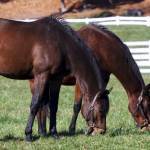Grazing for Horses with Chronic Laminitis

Laminitis is one of the most prevalent and devastating health issues among horses. Some horses develop laminitis due to a sudden shift in diet such as gorging on grain or grazing lush spring grass, and this is considered acute laminitis. Other horses develop chronic laminitis as a result of metabolic issues such as insulin resistance, metabolic syndrome, and obesity.
Often, horses with acute laminitis are able to return to their normal diets once the disease is under control. Chronically laminitic horses are frequently not so fortunate. For them, disease management is the goal, as a cure is not yet known. The question is, what type of nutritional restrictions are necessary for a horse with chronic laminitis? Because horses are foragers by nature, choosing the best grazing option requires thoughtful consideration.
Many horse owners use grazing as part of their feeding management. In many respects, forages are the ideal dietary components because they are rich in fiber, which horses are able to process efficiently for energy. However, fructans, a type of sugar inherent to some pasture grasses, are a cause for concern when considering how to graze a chronically laminitic horse. Fructans are dangerous because they are difficult, if not impossible, for a horse to digest. The high sugar content kills off beneficial microorganisms in the hindgut, releasing laminitis-inducing endotoxins into the blood.
The relative availability of fructans in a pasture varies over a 24-hour period and between seasons. Fructans accumulate during photosynthesis; early afternoon is the peak time for photosynthesis to occur. Thus, this is the time when fructans are concentrated in plants. Seasons with longer day length and favorable growing conditions also tend to promote the accumulation of fructans in plant tissues. Chronically laminitic horses should not be allowed to graze when fructans levels are high.
The specific types of forage present in a pasture have an impact on nutrition. Kathleen Crandell, Ph.D., a nutritionist at Kentucky Equine Research (KER), explains “Cool-season grasses tend to efficiently store sugars, especially during spring and fall when nighttime temperatures aren’t very high and respiration slows. When respiration slows, plants don’t use much stored sugar.” Because of this, the first step toward making informed nutritional decisions is understanding what forages are present in a pasture and when these forages are safest for consumption.
Because lush, fructan-rich pastures pose a threat to laminitic horses, some owners choose to modify their horse’s turnout. Crandell introduces two possibilities, use of a drylot or use of a grazing muzzle.
“A drylot is the safest type of turnout for the laminitic horse but not always an option for every horse owner. A muzzle is the next option for reducing and slowing the intake of grass,” she said. Turning out horses in a drylot allows them to enjoy freedom of movement, but it removes grazing from the equation. Grazing muzzles can be highly effective in slowing forage consumption in horses that are on pasture.
Chronic laminitis requires owners to provide vigilant care and develop a basic understanding of forage nutrition. Until a cure is found, dietary management is one of the best tools for combatting this disease.








